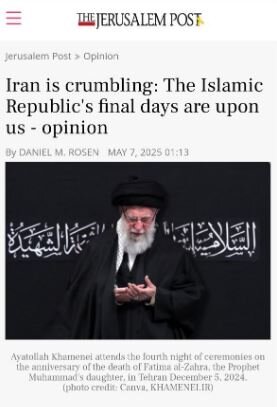Tehran – Daniel M. Rosen in a recent JPOST article cites the economic hardships brought on by US sanctions, evolving the situation in the West Asia region, claiming that he calls internal dissatisfaction. But predicting the imminent downfall of the Iranian government overlooks historic resilience, strategic readjustment and Tehran’s evolving regional attitude.
One of the arguments by Rosen about Iran’s suspicions of decline is the economic situation of the country. However, Tehran has repeatedly demonstrated adaptability under sanctions. Tehran has made it possible to build economic ties across the West, particularly with its Chinese, Russian and regional partners, allowing it to bypass traditional economic restrictions.
Tehran eases sanctions imposed by the West through mechanisms such as cryptocurrency trade and local currency trading. The country is promoting domestic production in sectors such as agriculture, pharmaceuticals and military technology, reducing its dependence on imports. Economic difficulties cannot be denied, but Iran’s ability to function within an alternative financial framework suggests that economic collapse is unforeseen.
The article argues that Iran’s military stance is suffering from major defeat, especially in Syria and Gaza. But that underestimates Hezbollah in Lebanon. Lebanon is an Iraqi resistance group, Yemen’s Ansalala movement, and can be seen as a major leverage of Iran’s defensive strategy to counter efforts to weaken Iran’s reach. Over the years, Iran has revised its defensive approach to highlight drone warfare, cyber operations and missile capabilities. Iran maintains control of the main shipping lanes of the Persian Gulf, and can put pressure on the World Trade Network in the event of an attack on its sovereign soil. Iran faces challenges in the West Asia region, which it labels as “paper tigers” and underestimates its ability to coordinate strategies and maintain regional influence.
Tehran faced multiple waves of uncertainty, some of which were openly or secretly supported by the Western government. However, as has been demonstrated over more than 40 years of Islamic Republic history, an uprising alone does not necessarily lead to a “change of government.” Iranian security equipment remains an important pillar of the province’s ability to counter the anti-Iranian elements. Tehran has developed a wide range of anti-intellectual abilities aimed at interfering with foreign interventions. Iranian security forces are closely monitoring entities that are working with foreign governments. They were able to dismantle multiple foreign spy networks, particularly those associated with Western intelligence agencies and regional enemies. Tehran has increased its ability to counter digital espionage and disrupts most of its hostile intelligence gathering efforts. While we may find frustration with a variety of issues that are primarily caused by Western sanctions, there is no single issue that a political entity can ride to launch a major uprising.
Also, elements of the anti-Islamic republic lack the unity to mobilize against Tehran. The revival of the “maximum pressure” strategy under the Trump administration is widely surrounded as a critical move to crippling Iran’s economy and ensuring its leadership submission. However, historical patterns suggest that such measures are consistently lacking for their intended purpose. Sanctions put economic tensions on Iran, but they failed to cause fundamental changes to its policy. Instead, these restrictions accelerated the strategic extremes of Iran’s alternative global actors, particularly Russia and China, and promoted deeper economic and political integration. By strengthening relations with these countries, Iran has eased the impact of Western financial restrictions.
Trade agreements, energy partnerships and alternative payment mechanisms allowed Tehran to maintain some economic stability despite external pressure. Furthermore, with the rise in non-dollar trade agreements and alternative banking mechanisms, increasing fragmentation of the global financial system further reduced the effectiveness of unilateral sanctions. In this context, the notion that maximum pressure could serve as the final blow to Iran appears to be increasingly tenuous. Rather than isolating Iran, these policies contribute to reorganization within a broader geopolitical framework and strengthen their role as a key player in multipolar global dynamics.
Iran’s involvement in diplomatic negotiations should not be interpreted as an act of despair, but as a calculated movement within a broader strategy aimed at securing national interests. Over the years, Tehran has demonstrated its ability to utilize negotiations as a means of extracting concessions, while maintaining its core political and strategic goals. Iran’s negotiating stance suggests strategic pragmatism rather than signaling surrender.
For decades, various analysts and policymakers have predicted the imminent collapse of Iran, citing economic distress, political agendas and external pressures. However, the Islamic Republic not only endured, but also showed responsive resilience in the face of adversity. From the devastating Iran-Iraq war to the period of severe economic hardships caused by international sanctions, Iran has repeatedly adapted to changing geopolitical and domestic realities.
This resilience stems from a combination of structural, political and social factors. Unlike authoritarian regimes that rely on a centralized, strict electricity structure, Iran maintains a complex governance system that blends Islam with democratic elements. This hybrid model includes institutions such as convenience councils and meetings of experts, providing mechanisms of political coordination and elite consensus. Furthermore, elections allow changes within the political landscape, helping the system to recalibrate rather than collapse under pressure.
Beyond political structures, Iran’s enduring socio-political unity plays an important role. Despite the differentiation of internal perspectives, the government maintains strong support among the masses. Furthermore, nationalist emotions and historical memory often reinforce Iran’s willingness to unify external pressure rather than destabilize. Therefore, rather than facing a sudden breakup, its ability to readjust Iran’s policies and strategically change the alliance emphasizes its long-term durability. The challenge remains, but the repeated survival of the system suggests that predictions of collapse cannot explain its adaptability and the evolving global order.

